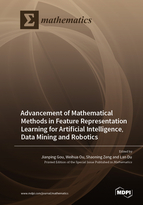Advancement of Mathematical Methods in Feature Representation Learning for Artificial Intelligence, Data Mining and Robotics
A special issue of Mathematics (ISSN 2227-7390). This special issue belongs to the section "Mathematics and Computer Science".
Deadline for manuscript submissions: closed (31 December 2022) | Viewed by 60085
Special Issue Editors
Interests: model compression; feature representation learning; deep dictionary learning; graph embedding; visual recognition
Special Issues, Collections and Topics in MDPI journals
Interests: cross media analysis; computer vision; camera-based vital sign measurement; machine learning
Special Issues, Collections and Topics in MDPI journals
Interests: multi-media analysis; computer vIsion; machine learning; deep learning
Special Issues, Collections and Topics in MDPI journals
Interests: machine learning; natural language processing; public health; healthcare
Special Issues, Collections and Topics in MDPI journals
Special Issue Information
Dear Colleagues,
The current Special Issue is devoted to the Advancement of Mathematical Methods in Artificial Intelligence, Data Mining and Robotics. Big data have boosted the rapid development of new techniques in Artificial Intelligence (AI), Data Mining and Robotics in the past decade. However, this development has been subject to the mathematical foundation under feature representation learning in the developed models, especially the ones based on deep neural networks. Due to this fact, the efficiency, reliability and security of the AI models are likely to be influenced. The topic of this Special Issue covers a wide range of algorithms, methods, and applications of explainable representation learning from the mathematical perspective. Topics of interest include but are not limited to:
1)Visual recognition methods and algorithms;
2)Explainable deep learning and its applications;
3)Theory of representation learning;
4)Data mining approaches;
5)Model compression
6)Deep dictionary learning
7)Knowledge discovery systems;
8)Human-based computer vision.
Prof. Dr. Jianping Gou
Prof. Dr. Weihua Ou
Dr. Shaoning Zeng
Dr. Lan Du
Guest Editors
Manuscript Submission Information
Manuscripts should be submitted online at www.mdpi.com by registering and logging in to this website. Once you are registered, click here to go to the submission form. Manuscripts can be submitted until the deadline. All submissions that pass pre-check are peer-reviewed. Accepted papers will be published continuously in the journal (as soon as accepted) and will be listed together on the special issue website. Research articles, review articles as well as short communications are invited. For planned papers, a title and short abstract (about 100 words) can be sent to the Editorial Office for announcement on this website.
Submitted manuscripts should not have been published previously, nor be under consideration for publication elsewhere (except conference proceedings papers). All manuscripts are thoroughly refereed through a single-blind peer-review process. A guide for authors and other relevant information for submission of manuscripts is available on the Instructions for Authors page. Mathematics is an international peer-reviewed open access semimonthly journal published by MDPI.
Please visit the Instructions for Authors page before submitting a manuscript. The Article Processing Charge (APC) for publication in this open access journal is 2600 CHF (Swiss Francs). Submitted papers should be well formatted and use good English. Authors may use MDPI's English editing service prior to publication or during author revisions.
Keywords
- visual recognition
- deep learning
- knowledge distillation
- representation learning
- data mining







